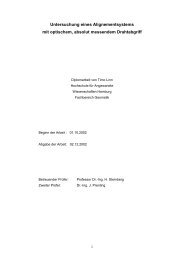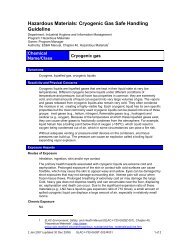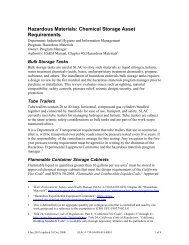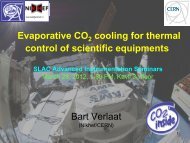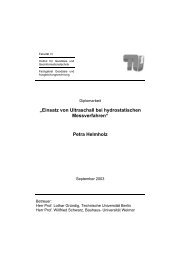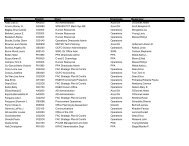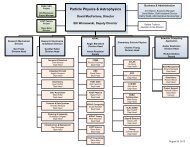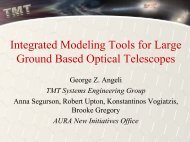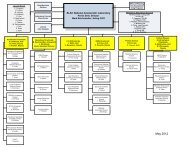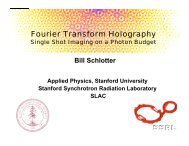BES - SLAC Group/Department Public Websites - Stanford University
BES - SLAC Group/Department Public Websites - Stanford University
BES - SLAC Group/Department Public Websites - Stanford University
Create successful ePaper yourself
Turn your PDF publications into a flip-book with our unique Google optimized e-Paper software.
FYO7 <strong>SLAC</strong> S CIENCE AND T ECHNOLOGY S ELF E VALUATION<br />
Objective 1.1 Science and Technology Results Provide Meaningful Impact on the Field<br />
SSRL carries out a broad user-based research program in the physical, chemical and biological<br />
sciences as well as in targeted research areas through its facilities R&D activities. The user research<br />
is best seen through the extensive publications list presented in the <strong>Public</strong>ations Appendix1 and<br />
through the SSRL Highlights, which are available on the SSRL website. Selected accomplishments<br />
from the SSRL facilities R&D activities are described below.<br />
Inelastic Scattering and Advanced Spectroscopy Facility for SPEAR3: The high resolution x-ray<br />
spectrometer on BL6-2 has been upgraded with parts for a second multi-crystal component which<br />
will double the efficiency to a total of 14 analyzers. We have commissioned the instrument. The first<br />
Fe RIXS (resonant inelastic x-ray scattering) spectra were taken and the first Mn Kβ XES (x-ray<br />
emission spectroscopy) studies were also performed. These experiments are part of a program on<br />
time resolved studies that will employ wavelength dispersive XES optics. Two XRS (x-ray resonant<br />
scattering) studies on water in ambient and confined conditions were performed at BL6-2 and these<br />
were the first XRS studies successfully carried out at SSRL, demonstrating the feasibility of the XRS<br />
work. We have transferred much work XRS work previously carried out at the Advanced Photon<br />
Source (APS) to SSRL BL6-2. We will use this beam line until a dedicated beam line becomes<br />
available, as has been proposed.<br />
Molecular Environmental and Interface Science: Molecular Environmental and Interface Science<br />
(MEIS) research focuses on the fundamental interfacial, molecular- and nano-scale processes that<br />
control the reactivity of contaminants in the environment, nutrient cycling in soils and natural waters,<br />
and the properties of complex natural materials such as nano-biominerals. This research makes<br />
significant use of SSRL-based synchrotron x-ray absorption spectroscopy (XAS), wide-angle x-ray<br />
scattering (WAXS), small-angle x-ray scattering (SAXS), x-ray standing wave (XSW) spectroscopy,<br />
and photoemission spectroscopy (PES) to provide direct in-situ probes of physical and electronic<br />
structure. Research in these areas contributes directly to contaminant remediation technologies, cost<br />
mitigation and accelerated clean-up of contaminated DOE sites, improved storage of high level<br />
radioactive waste, the discovery of new materials and structures that can be used in energy-related<br />
applications, and improved understanding of the surface and environmental reactivity of materials<br />
used in advanced nuclear systems.<br />
A programmatic effort to build microspectroscopy and microdiffraction MEIS programs for<br />
environmental remediation science continued in FY07 with the commissioning of the imaging and<br />
XAS capabilities. In addition, the development of significant new data acquisition and analysis<br />
software tools was completed. This facility has quickly developed a large user community.<br />
Chemical Physics of Surfaces and Liquids: This research program uses x-ray and electron<br />
spectroscopies to address chemical bonding on surfaces and in aqueous solutions. PES, XES, XAS<br />
and x-ray Raman spectroscopy provides an atom specific projection of the electronic structure.<br />
Problems related to systems in catalysis, energy technologies, electrochemistry and molecular<br />
environmental science are studied using these and density functional theory (DFT) calculations.<br />
Probing hydrogen bonding and the structure of liquid water in aqueous systems are new and novel<br />
applications of x-ray spectroscopic techniques.<br />
Instrument development is an important part of the activity to provide new spectrometers, and enable<br />
measurements at high gas pressures and at liquid interfaces. A wide range of problems is being<br />
addressed.<br />
Development of Resonant Coherent X-ray Scattering: This research has developed lensless<br />
imaging with sub 20 nm spatial resolution and includes investigation of charge and spin dynamics by<br />
1 http://www-group.slac.stanford.edu/oa/selfevaluation/2007/PubsAppendix.pdf<br />
F I N A L P A G E 5



